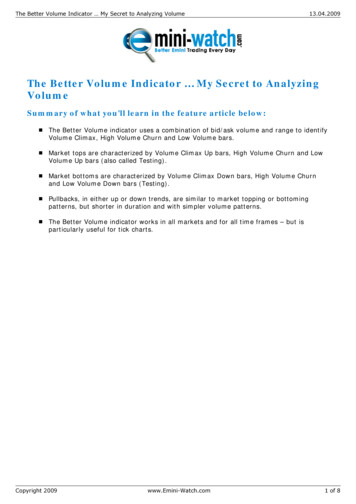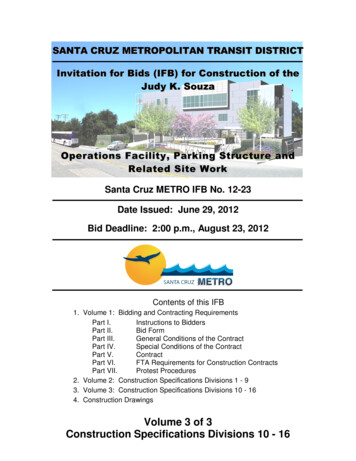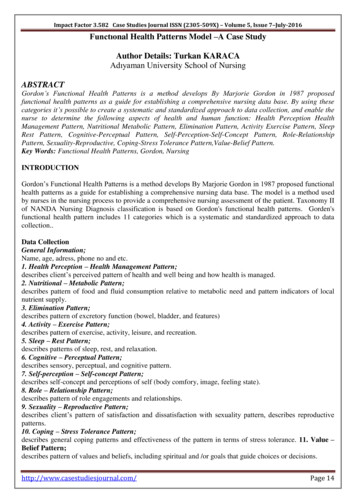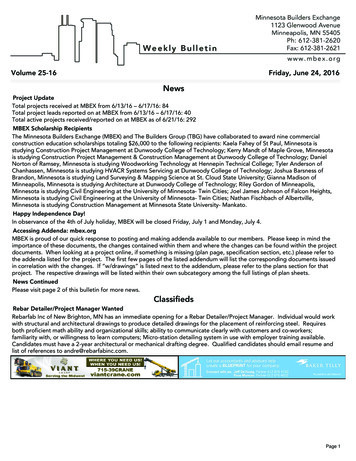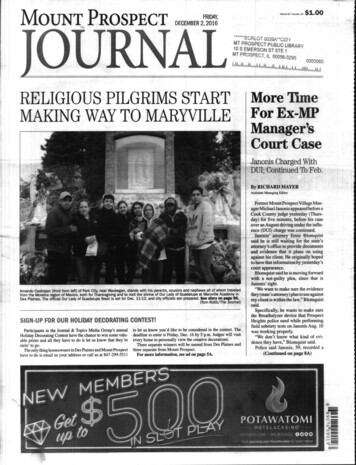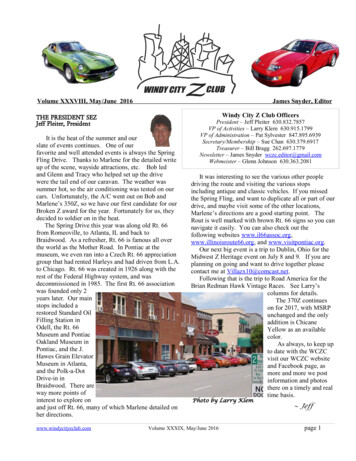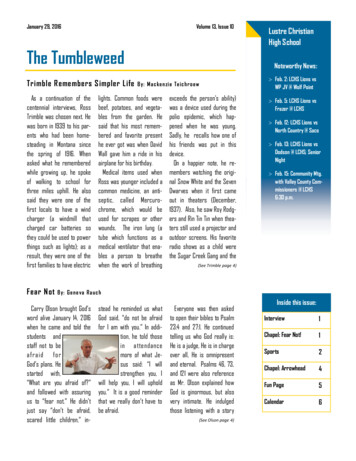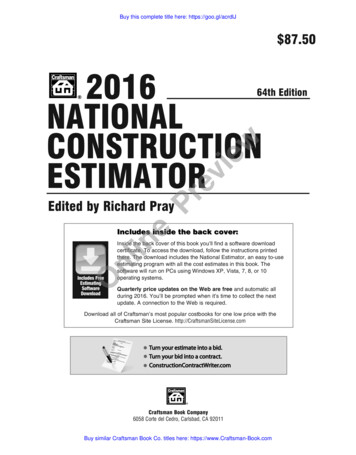
Transcription
2016 VOLUME 2Construction In BriefA quarterly publication brought to you byA Construction Manager asa Fiduciary in New York?MaybeBy Carol A. Sigmond and Gary J. Repke, Jr.In the words of iconic singer-songwriter Bob Dylan, “the times they are a-changin’.”A new case in New York may alter the legal relationship between owners and construction managers in the State. Traditionally, courts have viewed an owner and aconstruction manager as business partners, and their contract as an arms-lengthtransaction between equally sophisticated parties. Indeed, the New York courtshave firmly held that an owner cannot maintain an independent claim against aconstruction manager for breach of fiduciary duty, which alleges a violation of theduty of the utmost trust imposed on persons such as trustees, corporate officers,attorneys and estate executors. Courts routinely hold that such a claim is merelyduplicative of a breach of contract claim because the relationship between an ownerand a construction manager is contractually defined. Nevertheless, the U.S. DistrictCourt for the Eastern District of New York recently questioned this principle inUnited States v. Tishman Construction Corporation and suggested that constructionmanagers may be headed for fiduciary status and potential tort liability.On many construction projects today, both public and private, the owner of the subjectproperty retains a construction management firm whose primary responsibility is toensure that the contractors complete the work timely and in accordance with thearchitect’s and engineer’s drawings, specifications, and all local building codes. Inaddition, construction managers are often responsible for hiring and/or firing certaintradesmen, laborers and foremen.Under New York law, a fiduciary relationship is always fact-specific. It is groundedin a higher level of trust than normally present in the marketplace between personsinvolved in arms-length business transactions. As such, where parties haveentered into a contract, courts look to their agreement to determine the scopeof the parties’ relationship according to the contractual provisions establishingthe parties’ interdependency. If the parties do not expressly and unequivocallycreate their own relationship of higher trust, courts in New York traditionallyrefuse to elevate them to a higher realm of relationship or impose a stricterduty upon them.Continued on Page 3 IN THIS ISSUE24567What’s NewThe Small BusinessAdministration CouldBring About SubstantialChanges to Mentor-ProtégéPrograms in the Coming YearEnforcement of NewConstruction WorkerSafety Codes Beginsin PhiladelphiaWhen Creating a Trust, Timingis Everything: Measures toConsider As You Preserve YourAssets for the Next GenerationI’ve Been Terminated ona Construction Project –What Does This Mean?Contributors:Evan A. Blaker, Esq.Wayne C. Buckwalter, Esq.Jonathan A. Cass, Esq.Edward T. DeLisle, Esq.Matthew L. Erlanger, Esq.Shawn R. Farrell, Esq.Kerstin Isaacs, Marketing DirectorJames P. McGraw, Esq.Maria L. Panichelli, Esq.Carol A. Sigmond, Esq.Gary J. Repke, Jr., Esq.Jacqueline J. Ryan, Esq.Co-Editor-in-Chief:Ashling A. Ehrhardt, Esq.Co-Editor-in-Chief:Jennifer R. Budd, Esq.Associate Editor:Allie J. Hallmark, Esq.
What’s NewBrief Note:Greetings f om the Editorial Team at Const ctionIn Brief! We are excited about the Fir ’s officeex ansion in Kent cky and our new ManagingPar er in the Pit sburgh office! Have you given anythought to creating a t st to preser e assets for thenex generation? You will get a valuable over iewof options in this issue. We are also covering recentchanges in const ction worker safet codes inPhiladelphia and impor ant developments to keepin mind for const ction managers in New York.Happy itor-in-ChiefAssociate EditorBy Kerstin IsaacsPittsburgh Managing PartnerLisa Wampler has been named ManagingPartner of the Pittsburgh Office. Lisa is thefirst female managing partner in the Firm’shistory. She joined Cohen Seglias in 2003and has since developed an active anddiverse construction litigation practice.Lisa also serves as the Chair of the Firm’sWomen’s Initiative.Cohen Seglias’ Construction and Labor and EmploymentGroups Recognized by Chambers USANew FacePlease join us in welcoming Matthew Skaroff,who joins the Construction Group as an Associate in the Philadelphia office. Matt has gainedlitigation experience in both state and federalcourt since graduating from Villanova UniversitySchool of Law last year. While in law school,Matt worked as an extern in the United StatesDistrict Court for the District of Delaware forthe Honorable Mary Pat Thynge and served asArticles Editor for the Villanova Law Review.New Office LocationWe are pleased to announce the opening of our office in Louisville!This new location will help us better serve our clients in this area. Wewill keep you updated on events and developmentsin Kentucky in coming issues.ykcutneKinRoy CohenEd SegliasMarc FurmanThe Firm was once again recognized by Chambers USA as a leader inConstruction Law and Labor and Employment Law, highlighting in particular Roy Cohen, Ed Seglias and Marc Furman. We’d like to senda special thank you to our clients, as Chambers’ researchers rely heavilyon your feedback. We couldn’t have done it without you!New Practice and BlogPaul Thaler and Chris Carusone are heading up our new InternalInvestigations Practice, representing institutions and individualsfocusing on workplace investigations,scientific and researchmisconduct, andTitle IX investigations.Look out for theInternal Investigationsblog launching soon!Kerstin is the Firm’s Marketing Director. She can be reached at(215) 564-1700 or kisaacs@cohenseglias.com.2cohenseglias.com
A Construction Manager as a Fiduciary in New York?Continued from Page 1 By Carol A. Sigmond and Gary J. Repke, Jr.Enter Tishman. On December 10, 2015, theU.S. Attorney’s Office for the Eastern Districtof New York filed criminal fraud charges infederal court against Tishman ConstructionCorporation, one of the largest constructioncompanies in New York City. Over a tenyear period, Tishman provided constructionmanagement services on several significantprojects throughout New York. Tishmanwas largely responsible for supervising thework done by the subcontractors or tradecontractors, in addition to supplying workersfrom the Mason Tenders’ District Council ofGreater New York.The U.S. Attorney’s Office alleged thatTishman engaged in a fraudulent schemeby overbilling clients, including governmentcontracting and funding agencies, for hoursthat were not worked by the labor foremenon each project. Specifically, Tishman draftedand submitted time sheets to its clients, hours of overtime per daywhether worked or not, for certain senior labor foremen; and allowingother labor foremen to take paid sick time, major holidays, and oneor two weeks of vacation per year in violation of their collectivebargaining agreements. Tishman entered into a deferred prosecutionagreement with the U.S. Attorney’s Office, agreeing to pay morethan 20 million in restitution and penalties to its clients and thefederal government.The significance of the Tishman case is best recognized in conjunction with the current trend in New York to root out fraud in theconstruction industry. In fact, Tishman marks the third instanceof construction management fraud in the last several years. InMay 2015, another large construction company entered into anon-prosecution agreement and agreed to pay more than 7 millionin restitution and penalties for engaging in an eight-year fraudulentoverbilling scheme. Similarly, an experienced construction management firm that was charged in April 2012 with defrauding its clientsentered into a deferred prosecution agreement, and paid 56 millionin restitution and penalties for engaging in a ten-year overbillingscheme. In 2010, a Manhattan construction company was indictedin State court on charges connected to an alleged scheme to inflateconstruction costs for interior building projects across the Tri-Statearea by submitting false invoices from subcontractors to developersof various building projects, and collecting the extra money throughkickbacks from those subcontractors. The construction managementcompany and three of its officers pleaded guilty to grand larcenycharges and agreed to pay over 2 million in restitution. These criminalcases are notable because, as previously stated, New York law clearlyprovides that such business transactions should give rise to no moreduties than that required by the contract. Although these cases involvecriminal fraud, the jump by owners to civil fraud—a tort—is not long.Given this recent trend, construction management firms may be heldto a standard above and beyond mere contractual obligations. Otherjurisdictions grappling with this issue have traditionally swayed infavor of non-recognition with respect to fiduciary relationshipsbetween owners and construction managers. In Avon Bros., Inc. v.Tom Martin Construction Company, Inc., the New Jersey AppellateDivision found that a fiduciary relationship did not exist irrespectiveof an express provision in the contract stating that “the contractoraccepts the relationship of trust and confidence” with the owner.Similarly, in Construction Systems, Inc. v. Garlikov & Associates, Inc.,the Ohio Court of Appeals found that absent affirmative decisionmaking power or authority binding on an owner, the very essence ofa principal-agent relationship, a construction manager does not owethe owner a fiduciary obligation.To be clear, Tishman’s responsibility as a construction managerwas to contract certain labor foremen and to supervise the workperformed by subcontractors onsite. Indeed, the terms of theconstruction management contract between Tishman and itsclients specifically required that Tishman bill clients for work actuallyperformed. In theory, Tishman’s overbilling scheme gives rise to abreach of contract claim, nothing more. Tishman was not vested withthe authority to approve additional subcontract work or otherwisechange the project’s design such that its actions would bind theowner to those decisions. Nevertheless, New York courts arecarving out exceptions to this rule by indicting constructionmanagers for criminal fraud.As suggested above, the million-dollar question remains: when isa breach of fiduciary claim not duplicative of a breach of contract?The answer appears to be when a construction manager engages infraudulent practices. While the attractiveness of a breach of fiduciaryclaim to a disgruntled owner is readily apparent given the availabilityof punitive damages, a remedy not available in a breach of contractcase, courts have historically and consistently denied owners suchrelief. If New York’s trend continues, however, the transition fromcriminal fraud to civil liability, and consequently breach of fiduciary duty,is inevitable. For now, construction managers should be wary ofTishman and its implications on the construction industry in New York.Carol is a Partner with the Firm and Gary is an Associate, both practicingin the Construction Group. Carol can be reached at (212) 981-2927or csigmond@cohenseglias.com and Gary can be reached at(215) 564 -1700 or grepke@cohenseglias.com.cohenseglias.com3
The Small Business AdministrationCould Bring About SubstantialChanges to Mentor-ProtégéPrograms in the Coming YearBy Edward T. DeLisle, Maria L. Panichelli and Jacqueline J. RyanLast year, the Small BusinessAdministration (“SBA”) issuedproposed rules that will likely resultin major regulatory changes. Oneof the most important changesrelates to the SBA mentor-protégéprogram and has the potential tosubstantially alter the landscapeof that program, as well as smallbusiness contracting generally.By way of background, the federalgovernment currently attempts tosteer a percentage of governmentcontracts to small businesses by“setting aside” certain contractsexclusively for those businesses.As part of this effort, certain contracts are set aside for particulartypes of small businesses, namelythose participating in the SBA’s andDepartment of Veterans Affairs’(“VA”) small business programs.These include the SBA’s 8(a)program (for small, disadvantagedbusinesses), the SBA’s HUBZoneprogram (for small businesseslocated in historically under-utilizedbusiness zones), the SBA’s SDVOSB program (for service-disabledveteran-owned small businesses),the SBA’s WOSB/EDWOSBs program (for woman-owned/economically disadvantaged woman-owned small businesses), and, finally, the VA’s VOSB/SDVOSB program(for veteran-owned/service-disabled veteran owned smallbusinesses). Once a business is a qualified participantin one of the above programs, it is eligible for set-asidecontracts designated for the applicable type of business.However, small businesses can sometimes lose theirsmall business status if they are found to be “affiliated”with other businesses, rendering them ineligible forset-aside contracts. A finding of affiliation can be basedon a variety of factors but, generally speaking, any closeworking relationship between two companies poses anaffiliation risk. As a rule, joint venture partners arepresumed to be affiliated. This affiliation issue oftendiscourages small businesses from working with otherbusinesses, especially large businesses. Government mentor-protégé programs offer a potential solution to that issue.The purpose of government sponsored mentor-protégé(“MP”) programs is to partner established (and often large)business “mentors” with small business “protégés.”Through these MP programs, mentors provide both businessand technical assistance to their protégés, increasing the smallbusiness’s ability to win federal contracts. One additionalbenefit, currently applicable to the 8(a) MP program only, isthat joint venture partners in approved MP relationships aregenerally excluded from any “affiliation” analysis. In otherwords, large business “mentors” can assist 8(a) “protégés”and form joint ventures with those protégés, without worrying that the two businesses will be found “affiliated,” or thatthe protégé will lose its 8(a) status or eligibility.In February 2015, the SBA issued a proposed rule aimedat establishing one universal MP program open to all typesof SBA small businesses. As explained above, while jointventure partners are presumed to be affiliated as a generalrule, joint ventures formed between an 8(a) protégé andits approved mentor are an exception to that rule. In theproposed universal MP program, this exception would beexpanded to cover all SBA approved MP joint ventures.This means that HUBZones, SDVOSBs and WOSB/EDWOSBs—not just 8(a) businesses—could form affiliation-proof joint ventures with approved mentors. As in thecurrent 8(a) program, those joint ventures would then beeligible for any set-aside for which the protégé was eligible.Needless to say, this rule could mean big changes forconstruction companies, both large and small. Small businesses, supported by a mentor, will be able to competefor larger contracts than they might otherwise not havebeen capable of winning. Larger firms, by partnering witha small business protégé, will get access to set-asidecontracts for which they otherwise would be ineligible.The SBA estimates that if the proposed rule becomesfinal, approximately 2,000 small business companies whodo not currently qualify would likely become active in theuniversal mentor-protégé program. The SBA also projects4cohenseglias.com
Enforcement of NewConstruction Worker SafetyCodes Begins in PhiladelphiaBy Jonathan A. Cass and James P. McGrawThe City of Philadelphia has issued new code requirements for construction worker safety training. Thenew rules went into effect on October 1, 2015 and theDepartment of Licenses and Inspections (“L&I”) beganstrict enforcement on April 1, 2016.Under the new regulations, all contractors and employees (including subcontractors) performing constructionor demolition work in the City of Philadelphia for whichpermits have been issued are now required to completeOSHA 10 safety training, or an approved equivalent.This requirement applies to all trades, as well as stateregistered home improvement contractors. Workers arerequired to carry written proof establishing that they havecompleted an OSHA 10 training course while on thejob site, and their employers must also maintain on-siteproof of completion for each worker. This informationmust be furnished to L&I upon request. The OSHA10 training is only required to be completed once anddoes not expire.that this increased participation could result inprotégé firms obtaining as much as 2 billiondollars per year in federal contracts through theprogram.All of this is certainly good news. The mostcommon question we get from our clients is“When will the universal mentor protégé programgo into effect?” The answer is (hopefully) soon!In October 2015, individuals from the SBA testified before Congress, stating that the agencyhad organized a MP Program Expansion ProjectTeam to oversee the implementation of the newprogram, and that the final rule would be issuedin the first quarter of fiscal year 2016. In March,an SBA representative clarified that the finalrule should be issued this summer, and thatimplementation is set to begin in the fall.With this program set to begin within a few months,large businesses should consider making strategicalliances with small businesses as soon as possible. Of course, in order for small businesses totake full advantage of these potential opportunities,they should seek out strategic partners as well.Firms, both large and small, must be prepared forwhat could be a major shift in contracting practices.All businesses must adapt to become morecompetitive after the SBA finalizes its proposedrule in the coming year. We will most definitelykeep our eyes on this one.Additionally, all contractors licensed under Section 9-1004 of the PhiladelphiaCode must employ at least one supervisory employee who has completedOSHA 30 safety training, or an approved equivalent, within the past 5 years.Construction or demolition of major buildings requires continuous oversightby a site safety manager who has completed an OSHA 30 course. Thedesignated site safety manager must carry an identification card or certificateof completion issued by the provider of the OSHA 30 training course.The identification of an employee with OSHA 30 training and written proof ofcompletion were required for new contractor license applications made on orafter October 1, 2015, and will be required to be submitted with applicationsfor the renewal of contractor licenses which expired on or after March 31,2016. Licensed plumbing, electrical, fire suppression, and warm-air contractorsare exempt from this requirement.Ed is a Partner and Co-Chair of the Federal ContractingPractice Group, and Maria and Jacqueline areAssociates, both practicing in the Federal ContractingPractice Group. They can be reached at (215) 564-1700,edelisle@cohenseglias.com, mpanichelli@cohenseglias.com or jryan@cohenseglias.com.According to L&I, failure to comply with these new regulations will result inthe issuance of a violation notice and will subject the contractor to a fine.Repeated or egregious violations may result in the suspension or revocationof the contractor’s license. Given the occurrence of several widely publicizedbuilding collapses related to construction activities in Philadelphia,andpincreasing L&I budgets as a result, it is expectedthat inspections will be moree rigorous than afterpast code changes.Disclosure: Edward T. DeLisle is a member of theSection of Public Contract Law of the American BarAssociation and, as such, participated in drafting aComment on the Proposed Rule: Small BusinessGovernment Contracting and National DefenseAuthorization Act of 2013 Amendments.Jonathan is a Partner in the CommercialLitigation Group and Jim is ann Associatein the Construction Gro
construction management contract between Tishman and its clients specifically required that Tishman bill clients for work actually performed. In theory, Tishman’s overbilling scheme gives rise to a breach of contract claim, nothing more. Tishman was not vested with the auth
